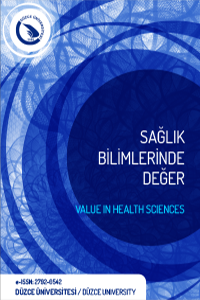Doğum Eyleminin İkinci ve Üçüncü Evresinde Sık Yapılan Uygulamalar ve Kanıta Dayalı Yaklaşım
Doğumun ikinci ve üçüncü evresi; kanıta dayalı yaklaşım; doğum eylemi; kanıta dayalı uygulamalar
-
Second and third stage of labor; evidence-based approaches; labor; evidence-based practices,
___
- Hofmeyr GJ. Evidence-based intrapartum care. Best Practice & Research Clinical Obstetrics and Gynaecology. 2005; 19(1): 103-15.
- Bilgin NÇ, Potur DC. Doğum sonu dönem kanıt temelli yaklaşımlar ve hemşirelik. Maltepe Üniversitesi Hemşirelik Bilim ve Sanatı Dergisi. 2010; 3(3): 80-7.
- Arslan H. Doğum eylemi. Coşkun A, editör. Kadın Sağlığı ve Hastalıları Hemşireliği El Kitabı. İstanbul: Koç Üniversitesi yayınları; 2012. s. 195-213.
- Güngör İ, Rathfish YG. Normal doğum eyleminin ikinci ve üçüncü evresinde kanıta dayalı uygulamalar. HEMAR-G. 2009; 11(2): 56-65.
- Cooke A. When will we change practice and stop directing pushing in labour? British Journal of Midwifery. 2010; 18(2): 77-81.
- Health.qld.gov.au [Internet]. Australia: Centre for Healthcare Improvement, 2012 [Cited: 2014 Apr 02]. Available from: http://www.health.qld.gov.au/qcg/ documents/g_normbirth.pdf.
- Rcm.org.uk [Internet]. London: The Royal College of Midwives, 2012 [Cited: 2014 Apr 02]. Available from: https://www.rcm.org.uk/sites/default/files/Second%20S tage%20of%20Labour.pdf.
- Verheijen EC, Raven JH, Hofmeyr GJ. Fundal pressure during the second stage of labour. Cochrane Database of Systematic Reviews. 2009; (4): CD006067. doi: 10.1002/14651858.CD006067.pub2.
- Asheim V, Nilsen ABV, Lukasse M, Reinar LM. Perineal techniques during the second stage of labour for reducing perineal trauma. Cochrane Database of Systematic Reviews. 2011; (12): CD006672. doi: 10.1002/14651858.CD006672.pub2.
- Serçekuş P, İşbir GG. Investigation of active birth method with evidence based practice. TAF Prev Med Bull. 2012; 11(1): 97-10.
- Gupta JK, Hofmeyr GJ, Shehmar M. Position in the second stage of labour for women without epidural anaesthesia. Cochrane Database of Systematic Reviews. 2012; 10.1002/14651858.CD002006.pub3. CD002006. doi:
- Carroli G, Mignini L. Episiotomy for vaginal birth. Cochrane Database of Systematic Reviews. 2009; (1): CD000081. doi: 10.1002/14651858.CD000081.pub2. (edited in 2012).
- FIGO Guıdelines, Safe Motherhood and Newborn Health (SMNH) Committee. Management of the second stage of labor. International Journal of Gynecology and Obstetrics. 2012; 119(2): 111-6. 14. Fawole B, Hofmeyr GJ. Maternal oxygen administration for fetal distress. Cochrane Database of Systematic Reviews. 2012; (12): CD000136. doi: 10.1002/14651858.CD000136.pub2.
- Hofmeyr GJ, Kulier R. Tocolysis for preventing fetal distress in second stage of labour. Cochrane Database of Systematic Reviews. 2011; (1): CD000037. doi: 10.1002/14651858.CD000037.
- Rcm.org.uk [Internet]. London: The Royal College of Midwives, 2012 [Cited: 2014 Apr 02]. Available from: https://www.rcm.org.uk/sites/default/files/Third%20Sta ge%20of%20Labour.pdf.
- McDonald SJ, Middleton P, Dowswell T, Morris PS. Effect of timing of umbilical cord clamping of term infants on maternal and neonatal outcomes. Cochrane Database of Systematic Reviews. 2013; (7): CD004074. doi: 10.1002/14651858.CD004074. pub3.
- Guideline.gov [Internet]. United States: Institute for Clinical Systems Improvement, 2010 [Cited: 2014 Apr 23]. Available from: http://www.guideline.gov/ content.aspx?id=47076&search=birth. 19. World Health Organization recommendations for the prevention and treatment of postpartum haemorrhage. Geneva (Switzerland): World Health Organization (WHO); 2012. (WHO). WHO
- Peña-Martí GE, Comunián-Carrasco G. Fundal pressure versus controlled cord traction as part of the active management of the third stage of labour. Cochrane Database of Systematic Reviews. 2007; (4): CD005462. doi: 10.1002/14651858.CD005462.pub2. Assessed as up-to-date: 16 SEP 2010.
- Sheldon WR, Winikoff B. Controlled cord traction in active management of the third stage of labour. Lancet. 2012; 380 (9848): 1146. doi: 10.1016/S0140- 6736(12)61664-X.
- Zupan J, Garner P, Omari AAA. Topical umbilical cord care at birth. Cochrane Database of Systematic Reviews. (3): 10.1002/14651858.CD001057.pub2. CD001057. doi:
- Imdad A, Bautista RM, Senen KA, Uy ME, Mantaring JB , Bhutta ZA. Umbilical cord antiseptics for preventing sepsis and death among newborns. Cochrane Database Syst Rev. 2013; (5): CD008635. doi: 10.1002/14651858.CD008635.pub2.
- Soltani H, Hutchon DR, Poulose TA. Timing of prophylactic uterotonics for the third stage of labour after vaginal birth. Cochrane Database of Systematic Reviews. (8): 10.1002/14651858.CD006173.pub2. CD006173. DOI:
- Mousa HA, Blum J, Abou El Senoun G, Shakur H, AlŞrevic Z. Treatment for primary postpartum haemorrhage. Cochrane Database of Systematic Reviews. (2): 10.1002/14651858.CD003249.pub3. CD003249. doi:
- Hofmeyr GJ, Abdel-Aleem H, Abdel-Aleem MA. for Uterine haemorrhage. Cochrane Database of Systematic Reviews. (7): 10.1002/14651858.CD006431.pub3. postpartum CD006431. DOI:
- Mchip.net [Internet]. United States: United States Agency, 2013 [Cited: 2014 Apr 02]. Available from: http://www.mchip.net/sites/ default/files/PPH%20Briefer %20(AMTSL).pdf.
- Moore ER, Anderson GC, Bergman N, Dowswell T. Early skin-to-skin contact for mothers and their healthy newborn infants. Cochrane Database Syst Rev. 2012; (5): 10.1002/14651858.CD003519.pub3. doi:
- Bayın G, Akbulut Y. Kanıta dayalı yaklaşım ve sağlık politikası. Ankara Sağlık Bilimleri Dergisi. 2012; 1(2): 115-32.
- Yayın Aralığı: Yılda 3 Sayı
- Başlangıç: 2022
- Yayıncı: Düzce Üniversitesi
Doğum Eyleminin İkinci ve Üçüncü Evresinde Sık Yapılan Uygulamalar ve Kanıta Dayalı Yaklaşım
Şükran BAŞGÖL, Nezihe KIZILKAYA BEJİ
Parotis Bezinde Lenfoepitelyal Karsinom Olgusu
Murat OKTAY, Selim ULUCANLI, Ethem İLHAN, Feyza BAŞAR, Hakan ATEŞ, Hüseyin YAMAN
Survivin Hakkında Bilinenler: Survivin İle İlgili Türkiye’de Yapılmış Olan Çalışmalar
Recep ERÖZ, Duygu BİRCAN, Hüseyin YÜCE, Recep ÖZMERDİVENLİ
Burcu KEMAL OKATAN, Beyhan MOLLAMEHMETOĞLU, Ayten LİVAOĞLU
Öğrencilerinin Cinsel Yolla Bulaşan Hastalıklar Konusundaki Bilgi Düzeyleri
Nazife BAKIR, Nezihe KIZILKAYA BEJİ
Sıfır Altı Yaş Arası Çocuğu Olan Annelerin Ev Kazalarına Yönelik Güvenlik Önlemlerinin Tanılanması
Esra TURAL BÜYÜK, Figen ÇAVUŞOĞLU, Esra TEKER
Nekrotizan Fasiit: Gecikmiş Cerrahi Müdahale Mortaliteyi Artırır
Türkay AKBAŞ, Hüseyin BİLGİN, Umut AYKUT, Sait KARAKURT
Postpartum Hemoraji Risk Değerlendirmesi, Yönetimi ve Ebe/Hemşirenin Rolü
Çocuk Ön Kol Kırıklarında Titanyum Kanal İçi Elastik Çivileme Tedavi Sonuçlarımız
Mehmet ARICAN, Kazım SOLAK, Hasan ARIK, Zekeria KARADUMAN, Kadir YILDIZ
